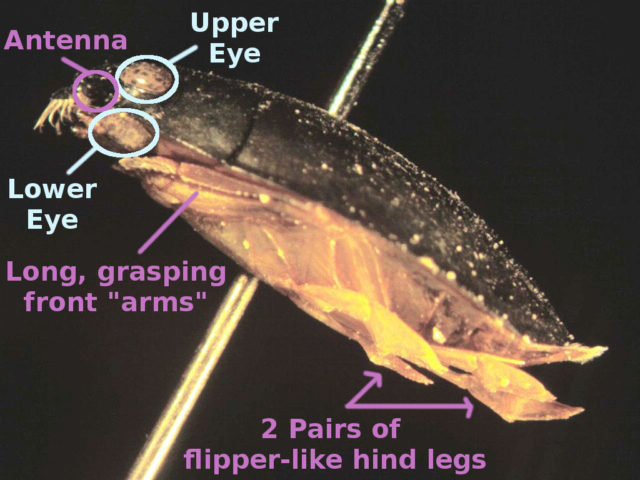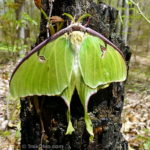The video below shows a group of Whirligig Beetles that I filmed swimming on the water’s surface at Hoover Mudflats. They are called “whirligig” beetles because of the way they whirl around in circles when disturbed as seen near the end of this short video.
Direct link to video: https://youtu.be/xk-B0_VyAX4
When I first saw these, I had no idea what I was looking at. Since then I’ve learned quite a bit about them, and they are fascinating little critters. Below is a photo one in profile showing off a number of the way these insects are adapted for aquatic life.
Whirligig beetles are so adapted to aquatic life that they can’t walk on land due to their rear “flippers”. However they can fly if they think a fish is about to eat them, or if they need to find a new home because their watery habitat is drying up. They prefer to spend their time swimming around on the surface of the water. Nonetheless they can dive underwater, and prior to doing so they can create what I think of as a “butt bubble” — a bubble of air that’s attached to their abdomen that acts as their scuba tank.
They essentially have a pair of eyes on each side of their heads. Well, it’s more properly described as two, divided compound eyes, but it certainly looks to the viewer as though this little insect has four eyes. While swimming around on the surface of the water, there are two eyes above the water and two eyes below the water. Their antennae are tiny little things sitting between the upper and lower portion of the compound eye. When swimming on the water’s surface, the antennae rest on the surface and actually let’s them do a sort of bat-like echo location. Using their unusual antennae they have a good mental model of what’s happening on the water’s surface and where things are located on the surface.
Among the things on the surface are their adult companions. In the event of insects, I don’t know what you’d call their group. A pack? A crowd? A swarm? Anyway they are social critters and hang out together. Scientists who have studied their group behavior report back that it is surprisingly complex. A beetle’s location in the group depends on a lot of factors. Two such factors are gender and degree of individual hunger. Beetles on the outside of the group have the least competition for food from their fellow beetles, but they are the most likely to be preyed upon by other creatures. The male beetles tend to be much more likely to engage in the high risk-taking, high reward outer positions. And the hungrier they are the more likely they are to be on the rim. However the YouTube video linked to in References below describes other factors that determine a beetles position in his group.
Although the explosion of motion in the video above was too fast for me to confirm this, despite living with many other beetles scientists say that when engaged in their seemingly chaotic whirling behavior, their amazing echo-locating antennae prevent them from running into one another. It is believed that the whirling behavior arose to confuse predators.
It sounds like the larval form of this beetles (which has gills and lives underwater) feeds as a predator, while the adult beetles tend to lead a more scavenging-like existence. But the adults will also engage in predation. For instance when a non-aquatic insect accidentally hits the water’s surface, its struggles will attract the aquatic Whirligig beetles who will finish it off.
I was surprised at how fast the little things can move. Apparently their little flipper legs can do 50 to 60 strokes per second when agitated.
When I filmed this I was on a boardwalk some distance above the beetles which looked like swimming watermelon seeds to me. Their bodies are black, but they are covered with a slippery coating that can give their blackness a shiny look. Apparently they are so slippery that it is very hard to hold onto one if you catch it. This would present a difficulty for the male when mating, except he has of course developed an adaptation of his own for such an important activity. His front, grasping legs have suction cups so the object of his affection doesn’t slip from his loving embrace. ![]()
Birds, fish and crayfish consider Whirligig Beetles to be tasty morsels.
Additional information
- Wikipedia: Whirligig beetle
- YouTube: Whirligig beetles by Backyard Bugs
More on Bugs





Great video and fascinating information.
Thanks, Eye on Nature! 🙂
That’s very neat!
Thanks, Neita. A couple years ago I had never even heard of these little creatures. It’s just amazing what nature has to offer.
What a great video / description (butt bubbles, hee!)… I’ve never seen these guys!! 🙂
I have seen Whirligig Beetles several times now when I’ve been visiting Hoover Mudflats Boardwalk. I swear… that place never disappoints.
Wow…I think “Whirligig” is a good name for them! 🙂
The first time I saw them I was just floored. I had no idea what they were. But I agree! “Whirligig” is the perfect name. 🙂